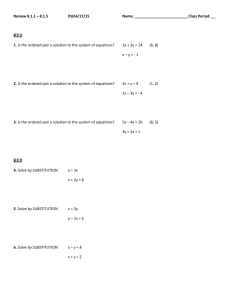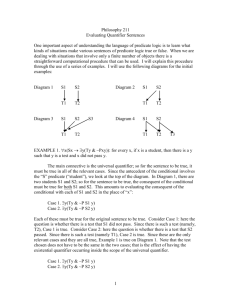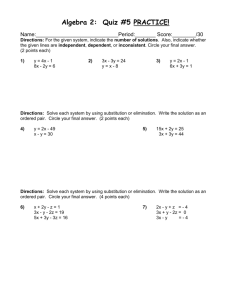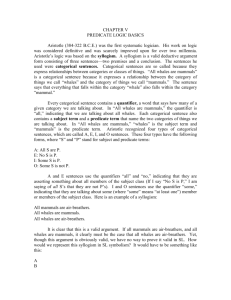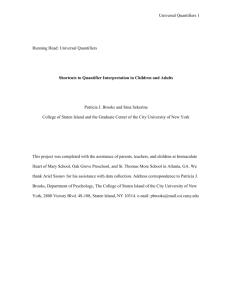Introduction to Symbolic Logic
advertisement
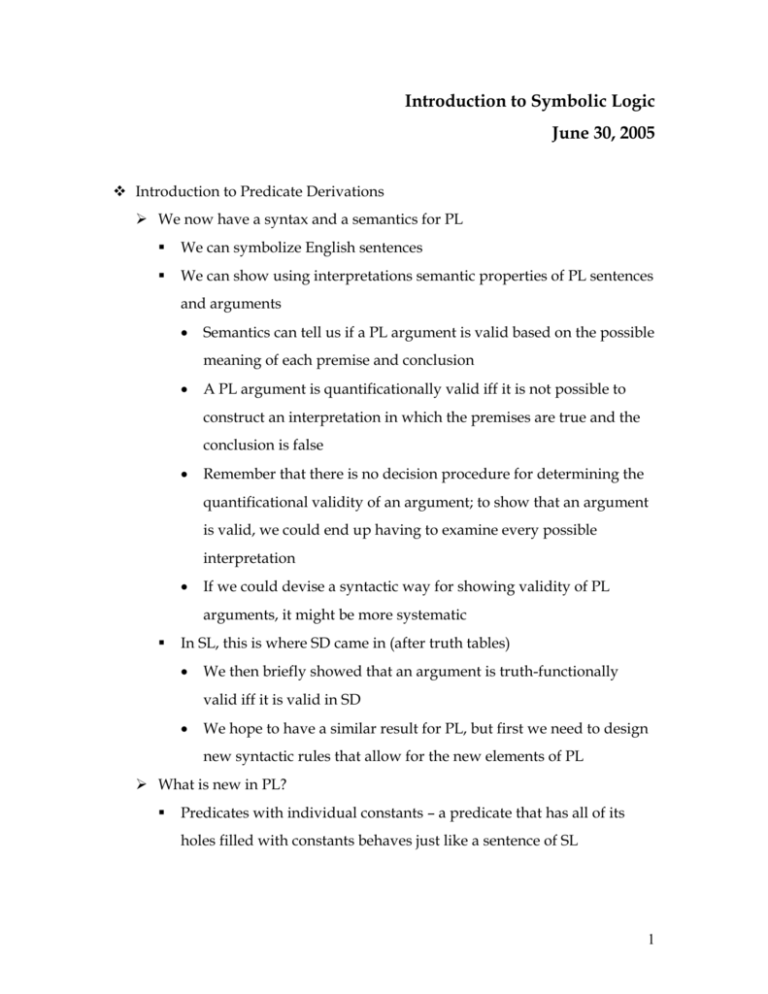
Introduction to Symbolic Logic June 30, 2005 Introduction to Predicate Derivations We now have a syntax and a semantics for PL We can symbolize English sentences We can show using interpretations semantic properties of PL sentences and arguments Semantics can tell us if a PL argument is valid based on the possible meaning of each premise and conclusion A PL argument is quantificationally valid iff it is not possible to construct an interpretation in which the premises are true and the conclusion is false Remember that there is no decision procedure for determining the quantificational validity of an argument; to show that an argument is valid, we could end up having to examine every possible interpretation If we could devise a syntactic way for showing validity of PL arguments, it might be more systematic In SL, this is where SD came in (after truth tables) We then briefly showed that an argument is truth-functionally valid iff it is valid in SD We hope to have a similar result for PL, but first we need to design new syntactic rules that allow for the new elements of PL What is new in PL? Predicates with individual constants – a predicate that has all of its holes filled with constants behaves just like a sentence of SL 1 Quantifiers and Variables – the quantifiers are two new logical operators Recall that each connective in SD is associated with two syntactic rules: introduction and elimination We need to be able to work with the quantifiers the same way, so essentially we need 4 new rules to create a new derivation system for PL, PD Using the SD rules on PL sentences Ignoring the new aspects of PL for the moment, PL sentences can be constructed in the exact same way as SL sentences This means that the same rules of SD can be applied in a PD proof in the same way Remember that the SD rules only work with their corresponding sentence types! It is the same in PD (ex. E still requires a conditional and its antecedent), but now the PL sentences that are being connected can be complex PL sentences themselves Example Here we have a negation as our conclusion. Or goal analysis strategy tells us that we should use ~I. If we ever want to prove a quantified sentence or use one that appears in the proof, we need introduction and elimination rules for each kind of quantifier Universal Elimination 2 Whenever we eliminate a quantifier we need to fill the hole left by the eliminated variable with an individual constant Remember that a PL expression that contains free variables is not a sentence, so, if you remove the quantifier, then you must remove all occurrences of the variable that was bound by the quantifier When we replace variables with constants, this is called variable substitution P(a/x) means that x is replaced with a wherever it appears in P Def. If P is a sentence of PL of the form (x)Q or (x)Q, and a is an individual constant, then Q(a/x) is a substitution instance of P. The constant a is the instantiating constant. A substitution instance is formed by dropping the initial quantifier and replacing all remaining occurrences of the variable that the quantifier contains with some constant Examples (y)Hay is a substitution instance of (x)(y)Hxy Hab is not a substitution instance of (x)(y)Hxy because only one substitution can be performed at once and it can only be performed on the initial quantifier Universal Elimination gives us a way to substitute any individual constant for the variable bound by the universal This makes sense given what we intend to mean, but it is important to keep in mind that the E is a syntactic rule so knowledge of the semantics of is not needed to use it. E can be applied to any sentence whose type is universal Note that it cannot be applied to a universal within a sentence if it is not the main logical operator 3 There are no restrictions on what constants can be substituted for a The constant can already be in the proof or it could be completely new The main thing to remember is to replace every occurrence of the variable with the constant so that you don’t end up with an open sentence Example Existential Introduction I allows us to introduce an existential sentence into our proof, either as a conclusion or a means to an end An existential sentence can always be created from a substitution instance That is, if a sentence appears with an individual constant, we can infer that that means there is at least one thing in the UD that has the predicate’s property or relation I does not require that every occurrence of an individual constant be existentially generalized Remember that ‘Rmm’ can be a substitution instance of 3 different sentences: (x)Rxx, (x)Rxm, and (x)Rmx Any one of these three sentences could be derived from ‘Rmm’ using I Example 1 4 Example 2 (x)(y)Cxy |-- (x)(y)Cxy Universal Introduction So far the two new derivation rules have been very simple because of the intended meaning for the quantifiers If we know that a sentence is a universal, we know that we can pull any constant out of the UD bag and do a substitution (E) If we know that a sentence with a constant is true (i.e. it’s in the proof), then we know that there is at least one time when something from the UD bag has that property (I) Universal Introduction allows us to prove or introduce a sentence, thereby saying that the sentence holds for any constant in the UD This is a very large claim! We can’t possibly show that a sentence is true for every constant, but, if we can show that an arbitrarily chosen constant holds, then we can derive the universal A constant is arbitrary iff the constant doesn’t occur in any sentence on which the validity of the inference depends The constant cannot appear in the inferred sentence (the one we get when we use I) or any undischarged assumption (P or PA) To use I, we must construct a subderivation that uses an arbitrary constant Example 1: 5 How did we get that?! The structure of this proof was determined by goal analysis for when the goal is a . We will talk about this much more tomorrow, but for now, notice that the immediate subformula of the conclusion is a conditional. We know that if we could get a substitution of that conditional using an arbitrary constant, then we could derive the we want Note that ‘a’ does not appear in either of the premises and that the PA is discharged on line 8. This makes ‘a’ arbitrary so line 9 is eligible for I Provided that: a does not occur in an undischarged assumption a does not occur in (x)P Existential Elimination The final new rule of PD allows us to make use of an when it appears in the proof Remember that only says that there is at least one thing in the UD that can be substituted for the variable, but we don’t know what that thing is E works a little bit like E (groan!) 6 It basically says: assume for the moment that the thing in the UD that the is talking about is named (some arbitrary constant), then prove your desired conclusion Provided that: a does not occur in an undischarged assumption a does not occur in (x)P a does not occur in Q Example Note that the desired conclusion never changes when you use this rule as a strategy ( just like E) We will see that this is another rule that takes effect before we begin goal analysis. That is, whenever an appears as a premise or PA, we have to switch to E so that we can make use of it Big Example Cf &Bfl, (x)(Cx & Bxf), (x)(y)(z)[(Bxy & Byz) Bxz] |-(z)[Cz & (Bzf & Bzl)] Homework 7 – due Monday All starred problems from section 10.1 There are two starred problems after each subsection introduces a new rule 7

